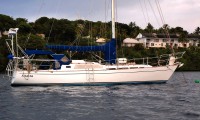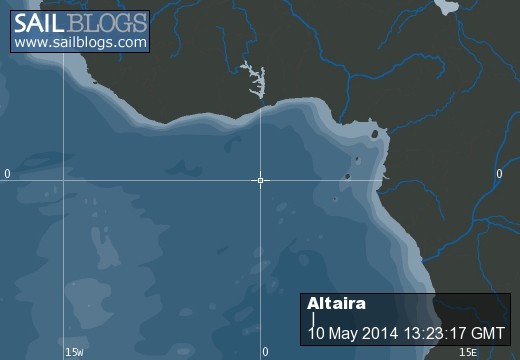Profile

Who: Kimball Corson. Text and Photos not disclaimed or that are obviously not mine are copyright (c) Kimball Corson 2004-2016
Port: Lake Pleasant, AZ
Altaira Wandering the Oceans
Favorites
- 7 Seas Cruising Association
- American Sailing Association
- Buoyweather Service
- CDC Traveler's Heath Advisories
- Cruiser Log venue
- Cruisers Forum
- Cruising Club of America
- Cruising Resources
- Cruising World Magazine
- Earthrace World Record
- Economic and Financial Indicators
- Economist Magazine
- Equipmment and Boat Reviews
- Float Plan Form
- Greenpeace Int'l
- Grib File Access
- Heavy Weather Sailing
- IMS Certificates
- Inland Travel: Expedia
- Intrade Prediction Markets
- Latitude 38
- London Financial Times
- Marine Books and Charts
- Marine Radios
- Nature Conservancy for Oceans
- New York Times
- NOAA Hurricane Analysis
- NOAA Weather Forecasts
- Noonsite, World Cruisng Info
- Ocean Cruising Club
- Overseas Mail Forwarding Services
- Practical Sailor Magazine
- RGE Economic Monitor
- Sail Gear Source I
- Sail Gear Source II
- Sail Gear Source III
- Sail Gear Source IV
- Sailboat Selection for Offshore Use
- Sailboats for Sale
- Sailing Items Sources Links
- SailMail (Marine Radio)
- Sailnet Sailing Information
- Seeking Alpha
- Tide & Current Program
- Tide Prediction Programs
- Tides & Currents
- TruthDig in the News
- U.S. Sailing Association
- Univ of Chicago Law Faculty Blog
- US State Dept Travel Advisories
- Voyage Planning (with pilot charts)
- Wall Street Journal
- Washington Post
- Weather.com
- Weather: MagicSeaweed
- Weather: Wetsand
- WinLink (Ham Radio)
- World Clock + Time Zones
09 April 2018 | Pago Pago, American Samoa
10 March 2018 | Pago Pago, American Samoa
10 March 2018 | Pago Pago, American Samoa
10 March 2018 | Pago Pago, American Samoa
22 August 2017 | Pago Pago, American Samoa
22 August 2017 | Pago Pago, American Samoa
22 August 2017 | Pago Pago, American Samoa
22 August 2017 | Pago Pago, American Samoa
22 August 2017 | Pago Pago, American Samoa
22 August 2017 | Pago Pago, American Samoa
22 August 2017 | Pago Pago, American Samoa
22 August 2017 | Pago Pago, American Samoa
22 August 2017 | Pago Pago, American Samoa
22 August 2017 | Pago Pago, American Samoa
22 August 2017 | Pago Pago, American Samoa
22 August 2017 | Pago Pago, American Samoa
22 August 2017 | Pago Pago, American Samoa
22 August 2017 | Pago Pago, American Samoa
22 August 2017 | Pago Pago, American Samoa
09 August 2017 | Pago Pago, American Samoa
Why Negative Interest Rates Might Not Be a Good Idea
03 September 2016 | Pago Pago, American Samoa
Kimball Corson

Consider interest payable or chargeable on a short term treasury --
---> 1 % interest with zero inflation
Holding a bond is better than cash or a demand deposit, although cash or a demand deposit is more liquid. Depends of degree of liquidity preference
---> 0 % interest with zero inflation
Holding cash or demand deposit is better because it is more liquid
---> -1 % interest with zero inflation
Holding cash or demand deposit is much better, i.e., hoarding is desirable.
But the question is negative interest rates on what? Savings deposits? The federal funds rate? The rate paid on bank deposits at the Fed? Or does it matter?
Four decades ago, Milton Friedman recommended that central banks like the Federal Reserve pay interest to depository institutions on the reserves they are required to hold against their deposit liabilities. This proposal was intended to improve monetary policy by making it easier to hit short-term interest rate targets. However, the Fed didn't have the authority to pay such interest until 2008. Then it acquired authority to pay interest on both required and excess reserves. Negative interest raises a legal problem because the legislative presumption was clearly positive interest rates.
Negative interest on reserves are intended to induce banks to lend more at lower rates and reduce their excess reserves. The three month treasury note is already at zero % percent yield. It is arguably better to hold or hoard cash, depending on liquidity preference.
There are three reasons negative rates on reserves might be ill considered.
First, they would increase private hoarding and off-shoring of cash by increasing liquidity preference.
Second, if negative rates were paid on total or excess bank reserves at the Fed, banks would have a greater incentive to lend and thereby compromise on lending standards. Alternatively, they might try to hold their own excess reserves which are the bulk of them. When the Fed started paying interest on total reserves held at the Fed, the ratio of excess to required reserves shot up hugely. The goal now is to reverse that and increase lending.
Finally, negative rates would spill out of reserves interest and that could push people out of notes and short term paper and into cash. Arbitrage and similar effects tend to equalize interest rates across like risk and similar considerations.
Kenneth Rogoff at Harvard is aware of the first and third of these problems and has just published a book, The Curse of Cash, proposing we eliminate cash from our monetary system or at least most of it, especially large denomination bills. His reasons are myriad, but his core motivation is his belief that negative interest rates will "give money that has been hibernating in the banking system a kick in the pants to get it out into the economy to stimulate demand thereby pushing up inflation and output." Assuming of course lending standards hold and we don't drown again in bad loans and again have a private debt liquidy crisis.
We might learn why negative rates could be a bad idea. We are treading into dangerous territory. The world of economic inter-meddling is historically overwhelmed with unintended consequences, as Friedman argued well. Negative rates and the elimination of cash are two major proposals. Negative rates are also arguably against the law.
---> 1 % interest with zero inflation
Holding a bond is better than cash or a demand deposit, although cash or a demand deposit is more liquid. Depends of degree of liquidity preference
---> 0 % interest with zero inflation
Holding cash or demand deposit is better because it is more liquid
---> -1 % interest with zero inflation
Holding cash or demand deposit is much better, i.e., hoarding is desirable.
But the question is negative interest rates on what? Savings deposits? The federal funds rate? The rate paid on bank deposits at the Fed? Or does it matter?
Four decades ago, Milton Friedman recommended that central banks like the Federal Reserve pay interest to depository institutions on the reserves they are required to hold against their deposit liabilities. This proposal was intended to improve monetary policy by making it easier to hit short-term interest rate targets. However, the Fed didn't have the authority to pay such interest until 2008. Then it acquired authority to pay interest on both required and excess reserves. Negative interest raises a legal problem because the legislative presumption was clearly positive interest rates.
Negative interest on reserves are intended to induce banks to lend more at lower rates and reduce their excess reserves. The three month treasury note is already at zero % percent yield. It is arguably better to hold or hoard cash, depending on liquidity preference.
There are three reasons negative rates on reserves might be ill considered.
First, they would increase private hoarding and off-shoring of cash by increasing liquidity preference.
Second, if negative rates were paid on total or excess bank reserves at the Fed, banks would have a greater incentive to lend and thereby compromise on lending standards. Alternatively, they might try to hold their own excess reserves which are the bulk of them. When the Fed started paying interest on total reserves held at the Fed, the ratio of excess to required reserves shot up hugely. The goal now is to reverse that and increase lending.
Finally, negative rates would spill out of reserves interest and that could push people out of notes and short term paper and into cash. Arbitrage and similar effects tend to equalize interest rates across like risk and similar considerations.
Kenneth Rogoff at Harvard is aware of the first and third of these problems and has just published a book, The Curse of Cash, proposing we eliminate cash from our monetary system or at least most of it, especially large denomination bills. His reasons are myriad, but his core motivation is his belief that negative interest rates will "give money that has been hibernating in the banking system a kick in the pants to get it out into the economy to stimulate demand thereby pushing up inflation and output." Assuming of course lending standards hold and we don't drown again in bad loans and again have a private debt liquidy crisis.
We might learn why negative rates could be a bad idea. We are treading into dangerous territory. The world of economic inter-meddling is historically overwhelmed with unintended consequences, as Friedman argued well. Negative rates and the elimination of cash are two major proposals. Negative rates are also arguably against the law.
Comments
| Vessel Name: | Altaira |
| Vessel Make/Model: | A Fair Weather Mariner 39 is a fast (PHRF 132), heavily ballasted (43%), high-aspect (6:1), stiff, comfortable, offshore performance cruiser by Bob Perry that goes to wind well (30 deg w/ good headway) and is also good up and down the Beaufort scale. |
| Hailing Port: | Lake Pleasant, AZ |
| Crew: | Kimball Corson. Text and Photos not disclaimed or that are obviously not mine are copyright (c) Kimball Corson 2004-2016 |
| About: | |
| Extra: |
Altaira's Photos - Main
No items in this gallery.
Profile

Who: Kimball Corson. Text and Photos not disclaimed or that are obviously not mine are copyright (c) Kimball Corson 2004-2016
Port: Lake Pleasant, AZ
Altaira Wandering the Oceans
Favorites
- 7 Seas Cruising Association
- American Sailing Association
- Buoyweather Service
- CDC Traveler's Heath Advisories
- Cruiser Log venue
- Cruisers Forum
- Cruising Club of America
- Cruising Resources
- Cruising World Magazine
- Earthrace World Record
- Economic and Financial Indicators
- Economist Magazine
- Equipmment and Boat Reviews
- Float Plan Form
- Greenpeace Int'l
- Grib File Access
- Heavy Weather Sailing
- IMS Certificates
- Inland Travel: Expedia
- Intrade Prediction Markets
- Latitude 38
- London Financial Times
- Marine Books and Charts
- Marine Radios
- Nature Conservancy for Oceans
- New York Times
- NOAA Hurricane Analysis
- NOAA Weather Forecasts
- Noonsite, World Cruisng Info
- Ocean Cruising Club
- Overseas Mail Forwarding Services
- Practical Sailor Magazine
- RGE Economic Monitor
- Sail Gear Source I
- Sail Gear Source II
- Sail Gear Source III
- Sail Gear Source IV
- Sailboat Selection for Offshore Use
- Sailboats for Sale
- Sailing Items Sources Links
- SailMail (Marine Radio)
- Sailnet Sailing Information
- Seeking Alpha
- Tide & Current Program
- Tide Prediction Programs
- Tides & Currents
- TruthDig in the News
- U.S. Sailing Association
- Univ of Chicago Law Faculty Blog
- US State Dept Travel Advisories
- Voyage Planning (with pilot charts)
- Wall Street Journal
- Washington Post
- Weather.com
- Weather: MagicSeaweed
- Weather: Wetsand
- WinLink (Ham Radio)
- World Clock + Time Zones
